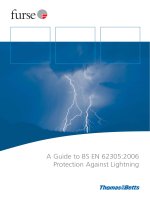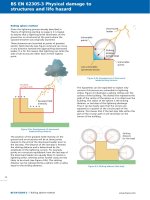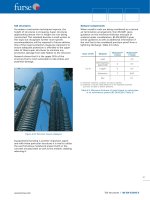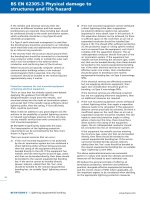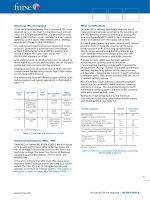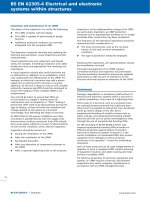Bsi bs en 00438 9 2010 + a1 2013
Bạn đang xem bản rút gọn của tài liệu. Xem và tải ngay bản đầy đủ của tài liệu tại đây (1.51 MB, 18 trang )
BS EN 438-9:2010+A1:2013
BSI Standards Publication
High-pressure decorative
laminates (HPL) — Sheets
based on thermosetting resins
(Usually called Laminates)
Part 9: Classification and specifications for
alternative core laminates
BRITISH STANDARD
BS EN 438-9:2010+A1:2013
National foreword
This British Standard is the UK implementation of
EN 438-9:2010+A1:2013. It supersedes BS EN 438-9:2010, which is
withdrawn.
The start and finish of text introduced or altered by amendment is
indicated in the text by tags. Tags indicating changes to CEN text carry
the number of the CEN amendment. For example, text altered by
CEN amendment A1 is indicated by !".
The UK participation in its preparation was entrusted to Technical
Committee PRI/76, Laminated sheet for decorative purposes.
A list of organizations represented on this committee can be
obtained on request to its secretary.
This publication does not purport to include all the necessary
provisions of a contract. Users are responsible for its correct
application.
© The British Standards Institution 2013.
Published by BSI Standards Limited 2013
ISBN 978 0 580 78899 4
ICS 83.140.20
Compliance with a British Standard cannot confer immunity from
legal obligations.
This British Standard was published under the authority of the
Standards Policy and Strategy Committee on 31 July 2010
Amendments/corrigenda issued since publication
Date
Text affected
31 December 2013
Implementation of CEN amendment A1:2013
EUROPEAN STANDARD
EN 438-9:2010+A1
NORME EUROPÉENNE
EUROPÄISCHE NORM
October 2013
ICS 83.140.20
English Version
High-pressure decorative laminates (HPL) - Sheets based on
thermosetting resins (Usually called Laminates) - Part 9:
Classification and specifications for alternative core laminates
Stratifiés décoratifs haute pression (HPL) - Plaques à base
de résines thermodurcissables (communément appelées
stratifiés) - Partie 9 : Classification et spécifications relatives
aux stratifiés avec autres types d'âmes
Dekorative Hochdruck-Schichtpressstoffplatten (HPL) Platten auf Basis härtbarer Harze (Schichtpressstoffe) -Teil
9: Klassifizierung und Spezifikationen für Schichtpressstoffe
mit alternativem Kernaufbau
This European Standard was approved by CEN on 19 May 2010 and includes Amendment 1 approved by CEN on 21 September 2013.
CEN members are bound to comply with the CEN/CENELEC Internal Regulations which stipulate the conditions for giving this European
Standard the status of a national standard without any alteration. Up-to-date lists and bibliographical references concerning such national
standards may be obtained on application to the CEN-CENELEC Management Centre or to any CEN member.
This European Standard exists in three official versions (English, French, German). A version in any other language made by translation under
the responsibility of a CEN member into its own language and notified to the CEN-CENELEC Management Centre has the same status as the
official versions.
CEN members are the national standards bodies of Austria, Belgium, Bulgaria, Croatia, Cyprus, Czech Republic, Denmark, Estonia, Finland,
Former Yugoslav Republic of Macedonia, France, Germany, Greece, Hungary, Iceland, Ireland, Italy, Latvia, Lithuania, Luxembourg, Malta,
Netherlands, Norway, Poland, Portugal, Romania, Slovakia, Slovenia, Spain, Sweden, Switzerland, Turkey and United Kingdom.
EUROPEAN COMMITTEE FOR STANDARDIZATION
COMIT É E UROPÉ E N DE NORMALISAT ION
E UROPÄISCHE S KOMIT E E FÜR NORMUNG
CEN-CENELEC Management Centre: Avenue Marnix 17, B-1000 Brussels
© 2013 CEN
All rights of exploitation in any form and by any means reserved worldwide
for CEN national Members.
Ref. No. EN 438-9:2010+A1:2013: E
BS EN 438-9:2010+A1:2013
EN 438-9:2010+A1:2013 (E)
Foreword
This document (EN 438-9:2010+A1:2013) has been prepared by Technical Committee CEN/TC 249
“Plastics”, the secretariat of which is held by NBN.
This European Standard shall be given the status of a national standard, either by publication of an identical
text or by endorsement, at the latest by April 2014, and conflicting national standards shall be withdrawn at the
latest by April 2014.
Attention is drawn to the possibility that some of the elements of this document may be the subject of patent
rights. CEN [and/or CENELEC] shall not be held responsible for identifying any or all such patent rights.
This document includes Amendment 1 approved by CEN on 2013-09-21.
This document supersedes EN 438-9:2010.
The start and finish of text introduced or altered by amendment is indicated in the text by tags !".
EN 438, High-pressure decorative laminates (HPL) — Sheets based on thermosetting resins (Usually called
Laminates), consists of the following parts:
Part 1: Introduction and general information
Part 2: Determination of properties
Part 3: Classification and specifications for laminates less than 2 mm thick intended for bonding to
supporting substrates
Part 4: Classification and specifications for Compact laminates of thickness 2 mm and greater
Part 5: Classification and specifications for flooring grade laminates less than 2 mm thick intended for
bonding to supporting substrates
Part 6: Classification and specifications for Exterior-grade Compact laminates of thickness 2 mm and
greater
Part 7: Compact laminate and HPL composite panels for internal and external wall and ceiling finishes
Part 8: Classification and specifications for design laminates
Part 9: Classification and specifications for alternative core laminates [this standard].
According to the CEN/CENELEC Internal Regulations, the national standards organizations of the following
countries are bound to implement this European Standard: Austria, Belgium, Bulgaria, Croatia, Cyprus, Czech
Republic, Denmark, Estonia, Finland, Former Yugoslav Republic of Macedonia, France, Germany, Greece,
Hungary, Iceland, Ireland, Italy, Latvia, Lithuania, Luxembourg, Malta, Netherlands, Norway, Poland, Portugal,
Romania, Slovakia, Slovenia, Spain, Sweden, Switzerland, Turkey and the United Kingdom.
2
BS EN 438-9:2010+A1:2013
EN 438-9:2010+A1:2013 (E)
Contents
Page
1
Scope ................................................................................................................................................4
2
Normative references .......................................................................................................................4
3
Terms and definitions ......................................................................................................................4
4
Material types and classification system ........................................................................................ 5
5
5.1
5.2
5.2.1
5.2.2
5.2.3
5.2.4
5.2.5
5.3
5.3.1
5.3.2
5.4
5.4.1
5.4.2
5.4.3
Requirements ...................................................................................................................................5
Compliance.......................................................................................................................................5
Inspection requirements ..................................................................................................................6
General .............................................................................................................................................6
Colour and pattern ...........................................................................................................................6
Surface finish ...................................................................................................................................6
Reverse side .....................................................................................................................................6
Visual inspection..............................................................................................................................6
Dimensional tolerance requirements .............................................................................................. 7
Dimensional tolerance requirements for coloured core laminates................................................ 7
Dimensional tolerances requirements for metal reinforced core laminates ................................. 8
Test requirements ............................................................................................................................9
General requirements for coloured core laminates ........................................................................ 9
General requirements for metal reinforced core laminates ......................................................... 11
Reaction to fire ............................................................................................................................... 12
Annex A (informative) Information on reaction to fire ............................................................................... 13
Bibliography................................................................................................................................................ 14
3
BS EN 438-9:2010+A1:2013
EN 438-9:2010+A1:2013 (E)
1
Scope
This European Standard specifies performance requirements for high-pressure decorative laminates (HPL)
intended for interior use, the core compositions of which are not covered by EN 438-3 [1] to EN 438-6 [4] and
EN 438-8 [5]. The core composition types (coloured core and metal reinforced core) are defined in this part of
EN 438.
EN 438-2 specifies the test methods relevant to this part of EN 438.
2
Normative references
The following referenced documents are indispensable for the application of this document. For dated
references, only the edition cited applies. For undated references, the latest edition of the referenced
document (including any amendments) applies.
EN 438-2:2005, High-pressure decorative laminates (HPL) — Sheets based on thermosetting resins (usually
called Laminates) — Part 2: Determination of properties
EN 12721, Furniture — Assessment of surface resistance to wet heat
EN ISO 178, Plastics — Determination of flexural properties (ISO 178:2001)
EN ISO 527-2, Plastics — Determination of tensile properties — Part 2: Test conditions for moulding and
extrusion plastics (ISO 527-2:1993 including Corr 1:1994)
EN ISO 1183-1, Plastics — Methods for determining the density of non-cellular plastics — Part 1: Immersion
method, liquid pyknometer method and titration method (ISO 1183-1:2004)
EN ISO 12572, Hygrothermal performance of building materials and products — Determination of water
vapour transmission properties (ISO 12572:2001)
ISO 11664-2:2007, Colorimetry — Part 2: CIE standard illuminants
3
Terms and definitions
For the purposes of this document, the following terms and definitions apply.
3.1
high pressure process
process for producing laminate(s) by simultaneous application of heat (temperature ≥ 120 °C) and high
specific pressure (≥ 5 MPa), to provide flowing and subsequent curing of the thermosetting resins
3.2
high-pressure decorative alternative core laminate(s)
alternative core laminate(s)
HPL
sheet(s) consisting of decorative surface layers and alternative core layers bonded together by a high
pressure process
NOTE 1
For alternative core layers, see 3.3.
NOTE 2
The surface layer(s) on one or both face(s), having decorative colours or designs, impregnated with melamine
based resins are supported by a core. The surface layers can appear on one or both side(s) of the laminate(s). In case of
one-sided laminates the back of the sheet(s) is made suitable for adhesive bonding to a substrate.
4
BS EN 438-9:2010+A1:2013
EN 438-9:2010+A1:2013 (E)
3.3 Types of alternative core laminates according to the core compositions
3.3.1
coloured core laminate
high-pressure decorative alternative core laminate, the core of which consists of cellulosic fibrous layers
(normally paper) impregnated with thermosetting resins typically aminoplastic thermosetting resins
NOTE 1
To achieve a coloured laminate, either the cellulosic fibres or the resins can be coloured. A translucent
laminate can be achieved by using clear resins and bleached fibres.
NOTE 2
The surface and the core layers can have the same colour producing a uniformly coloured laminate or be
different colours to achieve a succession of coloured layers.
3.3.2
metal reinforced core laminate
high-pressure decorative alternative core laminate, the core of which consists of metal layer(s) or mesh(es)
and cellulosic fibrous layers (normally paper) impregnated with phenolic or aminoplastic thermosetting resins.
NOTE
The purpose of including the metal layers is to improve the mechanical, fire or permeability performances of
the laminate. Additionally the metal layers can give aesthetic improvements to edge.
4
Material types and classification system
Alternative core laminates are defined using a three-letter classification system as shown in Table 1.
Table 1 — Alternative core laminate classification system
First letter
B
(Coloured core laminate)
!R" (Metal reinforced core laminate)
Second letter
Third letter
C
(Compact)
S
(Standard grade)
T
(Thin laminate < 2 mm)
or F (Flame retardant grade)
Type S – Standard grade high-pressure decorative alternative core laminates.
Type F – High-pressure decorative alternative core laminates with improved fire retardance, similar to type S
but also complying with special requirements of specified tests which may vary according to the application
(e. g. construction, marine, transport) and the country of use (see 5.4.3).
NOTE
These types of laminate are normally not postformable.
In addition to the abbreviation "HPL" and the number of this European Standard, materials are specified by
the alphabetical classification system.
EXAMPLE
"Coloured core Standard
HPL/EN 438-9 BTS.
5
5.1
Grade Thin high-pressure decorative laminate" is
designated as
Requirements
Compliance
Alternative core laminates classified in Table 1 shall comply with all appropriate requirements specified in 5.2,
5.3 and 5.4. This applies to both full-size sheets and cut-to-size panels.
5
BS EN 438-9:2010+A1:2013
EN 438-9:2010+A1:2013 (E)
5.2
Inspection requirements
5.2.1
General
Inspection shall be carried out in accordance with EN 438-2:2005, Clause 4, at a distance of 1,5 m.
5.2.2
Colour and pattern
When inspected in daylight or D65 standard illuminant, as specified in ISO 11664-2:2007, and also under
tungsten-filament lightning illuminant A as specified in ISO 11664-2:2007, a slight difference between the
corresponding colour reference sample held by the supplier and the specimen under test is acceptable.
When colour and surface finish are critical, it is recommended that sheets are checked for colour and surfacefinish compatibility without protective film before fabrication or installation.
5.2.3
Surface finish
When inspected at different viewing angles, there shall be no significant difference between the corresponding
surface-finish reference sample held by the supplier and the specimen under test.
When colour and surface finish are critical, it is recommended that sheets are checked for colour and surfacefinish compatibility without protective film before fabrication or installation.
5.2.4
Reverse side
The reverse side of single-sided sheets shall be suitable for adhesive bonding (e.g. sanded). In the case of
sanded backs, slight chatter marks shall be permitted.
5.2.5
5.2.5.1
Visual inspection
General
The following inspection requirements are intended as a general guide, indicating the minimum acceptable
quality for laminates. Cut-to-size panels and certain applications involving full-size sheets may call for special
quality requirements which can be negotiated between supplier and purchaser; in such cases the following
requirements may be used as a basis for agreement. It shall be noted that only a small percentage of sheets
in a batch (the level to be agreed with the customer) shall contain defects of the minimum acceptable level.
It may be agreed between purchaser and supplier that the visual quality standard applies to one decorative
face only.
5.2.5.2
Surface quality
The following surface defects are permissible:
Dirt, spots and similar surface defects
The admissible size of such defects is based on a maximum contamination area equivalent to
2
2
1,0 mm /m of laminate and is proportional to the sheet size under inspection.
The total admissible area of contamination may be concentrated in one spot or dispersed over an
unlimited amount of smaller defects.
6
BS EN 438-9:2010+A1:2013
EN 438-9:2010+A1:2013 (E)
Fibres, hairs and scratches
The admissible size of defects is based on a maximum contamination length equivalent to 10 mm/m2 of
laminate and is proportional to the sheet size under inspection.
The total admissible length of contamination may be concentrated in one defect or dispersed over an
unlimited amount of smaller defects.
5.2.5.3
Edge quality
For thin laminates visual defects (e.g. moisture marks, lack of gloss, corner damage, etc.) can be present on
all four edges of the laminate, providing the defect-free length and width are at least the nominal size minus
20 mm.
For compact laminates edge chipping up to 3 mm on each side is permissible.
5.3
5.3.1
Dimensional tolerance requirements
Dimensional tolerance requirements for coloured core laminates
Dimensional tolerance requirements for coloured core laminates are specified in Tables 2 and 3.
Table 2 — Dimensional tolerance requirements for thin coloured core laminates
Property
Test method
Requirement
(EN 438-2:2005, Clause no.)
Thickness
5
0,5 ≤ t ≤ 1,0 mm: maximum variation ± 0,15 mm
1,0 < t < 2,0 mm: maximum variation ± 0,18 mm
(where t: nominal thickness of the thin coloured core
laminate)
Flatness a
9
maximum deviation: 100 mm/m
Length and width b
6
+10
0 mm
Straightness of edges b
7
maximum deviation: 1,5 mm/m
Squareness b
8
maximum deviation: 1,5 mm/m
a
Provided that the thin coloured core laminates are stored in the manner and conditions recommended by the manufacturer,
they shall comply with the flatness requirements specified in Table 2 when measured in accordance with EN 438-2:2005,
Clause 9.
b
Tolerances for cut-to-size panels shall be agreed between supplier and purchaser.
7
BS EN 438-9:2010+A1:2013
EN 438-9:2010+A1:2013 (E)
Table 3 — Dimensional tolerance requirements for compact coloured core laminates
Property
Test method
Requirement
(EN 438-2:2005, Clause no.)
Thickness
5
2,0 ≤ t < 3,0 mm : maximum variation ± 0,25 mm
3,0 ≤ t < 5,0 mm : maximum variation ± 0,40 mm
5,0 ≤ t < 8,0 mm : maximum variation ± 0,50 mm
8,0 ≤ t < 12,0 mm : maximum variation ± 0,70 mm
12,0 ≤ t < 16,0 mm : maximum variation ± 0,80 mm
16,0 ≤ t < 20,0 mm : maximum variation ± 0,90 mm
20,0 ≤ t < 25,0 mm: maximum variation ± 1,00 mm
25,0 ≤ t: to be agreed between supplier and customer
(where t = nominal thickness of the compact coloured core
laminate)
Flatness a
9
2,0 ≤ t < 6,0 mm: 12,0 mm/m maximum deviation
6,0 ≤ t < 10,0 mm: 8,0 mm/m maximum deviation
10,0 ≤ t: 5,0 mm/m maximum deviation
(where t: nominal thickness of the compact coloured core
laminate)
Length and width b
6
+10
0 mm
Straightness of
edges b
7
maximum deviation: 1,5 mm/m
Squareness b
8
maximum deviation: 1,5 mm/m
a
Provided that the laminates are stored in the manner and conditions recommended by the manufacturer, they shall comply with
the flatness requirements specified in Table 3 when measured in accordance with EN 438-2:2005, Clause 9.
b
Tolerances for cut-to-size panels shall be agreed between supplier and purchaser.
5.3.2
Dimensional tolerances requirements for metal reinforced core laminates
Dimensional tolerance requirements for metal reinforced core laminates are specified in Tables 4 and 5.
Table 4 — Dimensional tolerance requirements for thin metal reinforced core laminates
Property
Test method
Requirement
(EN 438-2:2005, Clause no.)
Thickness
5
0,5 ≤ t < 2,0 mm: maximum variation ± 0,18 mm
(where t: nominal thickness of the thin metal reinforced core
laminate)
Flatness a
9
maximum deviation: 100 mm/m
Length and width b
6
+10
0 mm
Straightness of edges b
7
maximum deviation: 1,5 mm/m
Squareness b
8
maximum deviation: 1,5 mm/m
a
Provided that the laminates are stored in the manner and conditions recommended by the manufacturer, they shall comply with the
flatness requirements specified in Table 4 when measured in accordance with EN 438-2:2005, Clause 9.
b
8
Tolerances for cut-to-size panels shall be agreed between supplier and purchaser.
BS EN 438-9:2010+A1:2013
EN 438-9:2010+A1:2013 (E)
Table 5 — Dimensional tolerance requirements for compact metal reinforced core laminates
Property
Test method
Requirement
(EN 438-2:2005, Clause no.)
Thickness
5
2,0 ≤ t < 3,0 mm: maximum variation ± 0,25 mm
3,0 ≤ t < 5,0 mm: maximum variation ± 0,40 mm
5,0 ≤ t < 8,0 mm: maximum variation ± 0,50 mm
8,0 ≤ t < 12,0 mm: maximum variation ± 0,70 mm
12,0 ≤ t < 16,0 mm: maximum variation ± 0,80 mm
16,0 ≤ t < 20,0 mm: maximum variation ± 0,90 mm
20, 0 ≤ t < 25,0 mm: maximum variation ± 1,00 mm
25,0 ≤ t: to be agreed between supplier and customer
(where t: nominal thickness of the compact metal reinforced
core laminate)
Flatness a
9
2,0 ≤ t < 6,0 mm: 8,0 mm/m maximum deviation
6,0 ≤ t < 10,0 mm: 5,0 mm/m maximum deviation
10,0 ≤ t: 3,0 mm/m maximum deviation
(where t: nominal thickness of the compact metal reinforced
core laminate)
Length and width b
6
+10
0 mm
Straightness of edges b
7
maximum deviation: 1,5 mm/m
Squareness b
8
maximum deviation: 1,5 mm/m
a
Provided that the laminates are stored in the manner and conditions recommended by the manufacturer, they shall comply with the
flatness requirements specified in Table 5 when measured in accordance with EN 438-2, Clause 9.
b
Tolerances for cut-to-size panels shall be agreed between supplier and purchaser.
5.4
5.4.1
Test requirements
General requirements for coloured core laminates
General requirements are specified in Table 6.
9
BS EN 438-9:2010+A1:2013
EN 438-9:2010+A1:2013 (E)
Table 6 — General requirements for coloured core laminates
Property
Resistance to
surface wear
Test method
(EN 438-2:2005,
Clause no. unless
otherwise stated)
Wear
resistance
10
Appearance
Resistance to
immersion in
boiling water
Mass
increase
12
Thickness
increase
Laminate grade
Unit
Property or
attribute
(max. or min.)
Revolutions (min.)
Initial Point
Wear value
Rating (min.)
Gloss finish
Other finishes
% (max.)
2 mm ≤ t < 5 mm
t ≥ 5 mm
% (max.)
2 mm ≤ t < 5 mm
t ≥ 5 mm
Rating (min.)
Gloss finish
Other finishes
Rating (min.)
Gloss finish
Other finishes
% (max.)
La
t < 2 mm
Tb
2 mm ≤ t < 5 mm La
Tb
t ≥ 5 mm
La
Tb
BTS
BCS
150
350
150
350
3
4
3
4
–
–
5,0
3,0
–
–
6,0
4,0
3
4
3
4
3
4
0,80
1,40
3
4
–
–
–
–
–
–
0,60
1,00
0,50
0,80
Surface: 4
Core: 3 c
Resistance to
water vapour
14
Appearance
Resistance to
dry heat
16
Appearance
Dimensional
stability at
elevated
temperature
17
Cumulative
dimensional
change
Resistance to
crazing
24
Appearance
Rating (min.)
–
Resistance to
scratching
25
Appearance
Rating (min.)
Gloss finish
Other finishes
2
3
2
3
Resistance to
staining
26
Appearance
Rating (min.)
Groups 1 and 2
Group 3
5
4
5
4
27
Contrast
Grey scale rating
(min.)
Surface: 4 d
Core: 3 d
Surface: 4 d
Core: 3 d
30
Appearance
Rating (min.)
Light fastness
(xenon arc)
Resistance to
cigarette burns
Density
Flexural strength
Flexural modulus
(E)
Tensile strength
3
3
3
EN ISO 1183-1
EN ISO 178 e
Density
Stress
g/cm (min.)
MPa (min.)
1,40
–
1,40
80
EN ISO 178 e
Stress
MPa (min.)
–
9 000
Stress
MPa (min.)
–
60
EN ISO 527-2
f
a
L: in the longitudinal (or machine) direction of the fibrous sheet material (normally the direction of the longest dimension of the
laminate).
b
T: in the cross-longitudinal (cross-machine) direction of the fibrous sheet material (at right angles to direction L).
c
The moderate cracks lines run along all the edge of the specimen.
d
Extraneous darkening and/or photochromism are due to the shock effect of accelerated exposure and are not characteristics of
natural exposure.
e
Machine crosshead speed 2 mm/min.
f
Specimen type 1A. Machine crosshead speed 5 mm/min.
10
BS EN 438-9:2010+A1:2013
EN 438-9:2010+A1:2013 (E)
5.4.2
General requirements for metal reinforced core laminates
General requirements are specified in Table 7.
Table 7 — General requirements for metal reinforced core laminates
Property
Resistance to
surface wear
Test method
(EN 4382:2005, Clause
no. unless
otherwise
stated)
10
Laminate grade
Wear resistance
Appearance
Resistance to
immersion in
boiling water
12
Mass increase
Thickness
increase
Resistance to
water vapour
14
Appearance
Resistance to
dry heat
16
Appearance
Resistance to
wet heat
(100 °C)
EN 12721
Appearance
Dimensional
stability at
elevated
temperature
17
Unit
Property or
attribute
Cumulative
dimensional
change
(max. or min.)
Revolutions (min.)
Initial Point
Wear value
Rating (min.)
Gloss finish
Other finishes
% (max.)
2 mm ≤ t < 5 mm
t ≥ 5 mm
% (max.)
2 mm ≤ t < 5 mm
t ≥ 5 mm
Rating (min.)
Gloss finish
Other finishes
Rating (min.)
Gloss finish
Other finishes
Rating (min.)
Gloss finish
Other finishes
% (max.)
L
t < 2 mm
T
2 mm ≤ t < 5 mm
T
b
t ≥ 5 mm
a
b
L
L
T
a
a
b
!RTS
RTF
RCS
RCF"
150
350
150
350
150
350
150
350
3
4
3
4
3
4
3
4
–
–
–
–
5,0
2,0
7,0
3,0
–
–
–
–
6,0
2,0
9,0
6,0
3
4
3
4
3
4
3
4
3
4
3
4
3
4
3
4
3
4
3
4
3
4
3
4
0,75
1,25
0,75
1,25
–
–
–
–
–
–
–
–
0,60
1,00
0,60
1,00
–
–
–
–
0,50
0,80
0,50
0,80
–
f
1 400
f
1 800
–
f
1 400
f
1 800
Resistance to
impact by large
diameter ball
(optional)
21
Drop height
Resistance to
cracking under
stress (optional)
23
Appearance
Rating (min.)
4
4
–
–
Resistance to
crazing
24
Appearance
Rating (min.)
–
–
4
4
Resistance to
scratching
25
Appearance
2
3
2
3
2
3
2
3
Resistance to
staining
26
Appearance
5
4
5
4
5
4
5
4
Light fastness
(xenon arc)
27
Contrast
Grey scale rating (min.)
Resistance to
cigarette burns
30
Appearance
Rating (min.)
g
mm (min.)
t < 2 mm
2 mm ≤ t < 6 mm
t ≥ 6 mm
Rating (min.)
Gloss finish
Other finishes
Rating (min.)
Groups 1 and 2
Group 3
1 000
–
–
4
c
3
f
1 000
–
–
4
c
3
f
4
c
3
4
c
3
11
BS EN 438-9:2010+A1:2013
EN 438-9:2010+A1:2013 (E)
Table 7 (continued)
Density
EN ISO 1183-1
Flexural
strength
EN ISO 178
Flexural
modulus (E)
EN ISO 178
Tensile strength
EN ISO 527-2
Permeability
EN ISO 12572
d
d
e
Density
3
g/cm (min.)
Stress
1,35
1,35
1,35
MPa (min.)
–
–
80
Stress
MPa (min.)
–
–
9 000
Stress
MPa (min.)
–
–
60
Permeability
µ
1,35
f
80
f
f
f
9 000
60
f
f
Wet cup = 110; Dry cup = 250
a
L: in the longitudinal (or machine) direction of the fibrous sheet material (normally the direction of the longest dimension of the
laminate).
b
T: in the cross-longitudinal (cross-machine) direction of the fibrous sheet material (at right angles to direction L).
c
Extraneous darkening and/or photochromism are due to the shock effect of accelerated exposure and are not characteristics of natural
exposure.
d
Machine crosshead speed 2 mm/min.
e
Specimen type 1A. Machine crosshead speed 5 mm/min.
f
By suitable design of the laminate much higher mechanical performances can be achieved.
g
When tested at the specified drop height, the diameter of indentation shall not exceed 10 mm.
5.4.3
Reaction to fire
For information on reaction to fire, see Annex A.
12
BS EN 438-9:2010+A1:2013
EN 438-9:2010+A1:2013 (E)
Annex A
(informative)
Information on reaction to fire
The requirements for reaction to fire are determined by the fire regulations of the country in which the material
is to be used.
In Europe, laminate panels intended for construction applications are tested in accordance with EN 13823 [6]
(SBI test) and EN ISO 11925-2 [7] (Small-burner test), and the resulting reaction-to-fire performance is
expressed in accordance with EN 13501-1 [8].
For applications other than construction, fire test methods and performance requirements may vary from one
country to another, and at present it is not possible, with any test, to predict compliance with all national and
other requirements.
All the products covered by this part of EN 438 will have different reaction to fire performance depending on
the composition and/or decorative surfaces. Reaction to fire will also depend on laminate thickness and
construction of the element, substrate type and thickness, and adhesive used. The laminate manufacturer
should be contacted for information on fire test methods, classifications and fire certification.
No fire performance test is therefore included in this part of EN 438.
13
BS EN 438-9:2010+A1:2013
EN 438-9:2010+A1:2013 (E)
Bibliography
[1]
EN 438-3, High-pressure decorative laminates (HPL) — Sheets based on thermosetting resins
(Usually called Laminates) — Part 3: Classification and specifications for laminates less than 2 mm
thick intended for bonding to supporting substrates
[2]
EN 438-4, High-pressure decorative laminates (HPL) — Sheets based on thermosetting resins
(Usually called Laminates) — Part 4: Classification and specifications for Compact laminates of
thickness 2 mm and greater
[3]
EN 438-5, High-pressure decorative laminates (HPL) — Sheets based on thermosetting resins
(Usually called Laminates) — Part 5: Classification and specifications for flooring grade laminates less
than 2 mm thick intended for bonding to supporting substrates
[4]
EN 438-6, High-pressure decorative laminates (HPL) — Sheets based on thermosetting resins
(Usually called Laminates) — Part 6: Classification and specifications for Exterior-grade Compact
laminates of thickness 2 mm and greater
[5]
EN 438-8, High-pressure decorative laminates (HPL) — Sheets based on thermosetting resins
(Usually called Laminates) — Part 8: Classification and specifications for design laminates
[6]
EN 13823, Reaction to fire tests for building products — Building products excluding floorings exposed
to the thermal attack by a single burning item
[7]
EN ISO 11925-2, Reaction to fire tests — Ignitability of building products subjected to direct
impingement of flame — Part 2: Single-flame source test (ISO 11925-2:2002)
[8]
EN 13501-1, Fire classification of construction products and building elements — Part 1:Classification
using data from reaction to fire tests
14
This page deliberately left blank
NO COPYING WITHOUT BSI PERMISSION EXCEPT AS PERMITTED BY COPYRIGHT LAW
British Standards Institution (BSI)
BSI is the national body responsible for preparing British Standards and other
standards-related publications, information and services.
BSI is incorporated by Royal Charter. British Standards and other standardization
products are published by BSI Standards Limited.
About us
Revisions
We bring together business, industry, government, consumers, innovators
and others to shape their combined experience and expertise into standards
-based solutions.
Our British Standards and other publications are updated by amendment or revision.
The knowledge embodied in our standards has been carefully assembled in
a dependable format and refined through our open consultation process.
Organizations of all sizes and across all sectors choose standards to help
them achieve their goals.
Information on standards
We can provide you with the knowledge that your organization needs
to succeed. Find out more about British Standards by visiting our website at
bsigroup.com/standards or contacting our Customer Services team or
Knowledge Centre.
Buying standards
You can buy and download PDF versions of BSI publications, including British
and adopted European and international standards, through our website at
bsigroup.com/shop, where hard copies can also be purchased.
If you need international and foreign standards from other Standards Development
Organizations, hard copies can be ordered from our Customer Services team.
Subscriptions
Our range of subscription services are designed to make using standards
easier for you. For further information on our subscription products go to
bsigroup.com/subscriptions.
With British Standards Online (BSOL) you’ll have instant access to over 55,000
British and adopted European and international standards from your desktop.
It’s available 24/7 and is refreshed daily so you’ll always be up to date.
You can keep in touch with standards developments and receive substantial
discounts on the purchase price of standards, both in single copy and subscription
format, by becoming a BSI Subscribing Member.
PLUS is an updating service exclusive to BSI Subscribing Members. You will
automatically receive the latest hard copy of your standards when they’re
revised or replaced.
To find out more about becoming a BSI Subscribing Member and the benefits
of membership, please visit bsigroup.com/shop.
With a Multi-User Network Licence (MUNL) you are able to host standards
publications on your intranet. Licences can cover as few or as many users as you
wish. With updates supplied as soon as they’re available, you can be sure your
documentation is current. For further information, email
BSI Group Headquarters
389 Chiswick High Road London W4 4AL UK
We continually improve the quality of our products and services to benefit your
business. If you find an inaccuracy or ambiguity within a British Standard or other
BSI publication please inform the Knowledge Centre.
Copyright
All the data, software and documentation set out in all British Standards and
other BSI publications are the property of and copyrighted by BSI, or some person
or entity that owns copyright in the information used (such as the international
standardization bodies) and has formally licensed such information to BSI for
commercial publication and use. Except as permitted under the Copyright, Designs
and Patents Act 1988 no extract may be reproduced, stored in a retrieval system
or transmitted in any form or by any means – electronic, photocopying, recording
or otherwise – without prior written permission from BSI. Details and advice can
be obtained from the Copyright & Licensing Department.
Useful Contacts:
Customer Services
Tel: +44 845 086 9001
Email (orders):
Email (enquiries):
Subscriptions
Tel: +44 845 086 9001
Email:
Knowledge Centre
Tel: +44 20 8996 7004
Email:
Copyright & Licensing
Tel: +44 20 8996 7070
Email:


